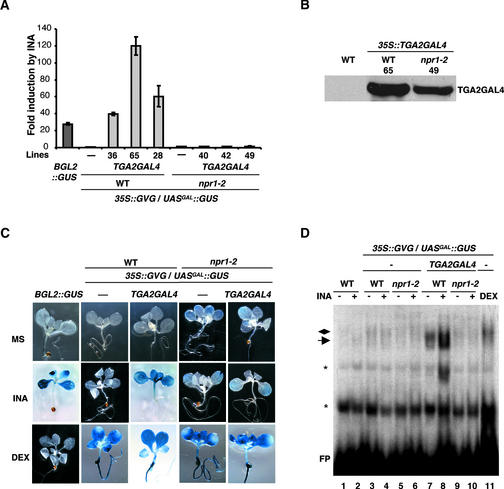Figure 5.
Characterization of TGA2GAL4 Transcriptional Activity in SAR Induction.
(A) Quantitative GUS assay of plants transformed with the chimera reporter system. Plants were grown on MS medium with and without 50 μM INA for 2 weeks, and GUS activities were measured using 4-methylumbelliferyl β-d-glucuronide as a substrate. The fold induction by INA was calculated for each genotype by comparing the GUS activity of INA-treated plants with that of untreated plants. The values represent averages of three replicates ±se. A transgenic line containing the INA-responsive BGL2::GUS reporter (Bowling et al., 1994; Cao et al., 1994) was used as a positive control. Three independent 35S::TGA2GAL4/UASGAL::GUS transformants in the wild-type background (WT; lines 28, 36, and 65) and three in the npr1-2 background (lines 40, 42, and 49) were examined.
(B) Protein gel blot analysis of the TGA2GAL4 protein in plants transformed with the chimera reporter system. Protein extracts were made from wild-type plants and wild-type and npr1-2 plants transformed with the chimera reporter system (lines 65 and 49, respectively). TGA2GAL4 and GVG were immunoprecipitated using a rabbit polyclonal antibody against GAL4-DBD (amino acids 1 to 147). The TGA2GAL4 protein then was detected using a mouse monoclonal antibody against residues 94 to 147 of GAL4-DBD. The GVG protein, which contains only amino acids 1 to 74 of GAL4-DBD, was not detected on this blot.
(C) Histochemical staining of GUS activities in plants transformed with the chimera reporter system. Plants were grown on MS medium (MS) or MS medium with 50 μM INA (INA) for 2 weeks. As controls, some plants for each genotype were taken from the MS plates, treated with 1 μM DEX in liquid MS medium for 24 h (DEX), and then stained for GUS.
(D) GMSA. Protein extracts were made from 2-week-old plants grown in MS medium with (+) or without (−) 50 μM INA or treated with DEX for 24 h (DEX). 35S::TGA2GAL4/UASGAL::GUS transgenic line 65 in the wild-type background and line 49 in the npr1-2 background were used. Each extract (20 μg) was incubated with a 32P-labeled probe (17-mer) containing UASGAL (4 × 104 cpm), and the mixtures were run on a 4% native PAGE gel. The protein-DNA complexes were detected by autoradiography. The arrow points to the TGA2GAL4-UASGAL complex, the diamond marks the GVG-UASGAL complex, and the asterisks indicate nonspecific complexes. FP, free probe.

